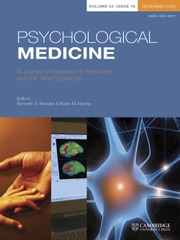No CrossRef data available.
Article contents
Resting-state network analysis of suicide attempt history in the UK Biobank
Published online by Cambridge University Press: 31 May 2023
Abstract
Prior research has identified altered brain structure and function in individuals at risk for self-directed violence thoughts and behaviors. However, these studies have largely utilized healthy controls and findings have been inconsistent. Thus, this study examined differences in resting-state functional network connectivity among individuals with lifetime suicide attempt(s) v. lifetime self-directed violence thoughts alone.
Using data from the UK Biobank, this study utilized a series of linear regressions to compare individuals with lifetime suicide attempt(s) (n = 566) v. lifetime self-directed violence thoughts alone (n = 3447) on within- and between- network resting-state functional connectivity subnetworks.
There were no significant between-group differences for between-network, within-network, or whole-brain functional connectivity after adjusting for age, sex, ethnicity, and body mass index and performing statistical corrections for multiple comparisons. Resting-state network measures may not differentiate between individuals with lifetime suicide attempt(s) and lifetime self-directed violence thoughts alone.
Null findings diverge from results reported in smaller neuroimaging studies of suicide risk, but are consistent with null findings in other large-scale studies and meta-analyses. Strengths of the study include its large sample size and stringent control group. Future research on a wider array of imaging, genetic, and psychosocial risk factors can clarify relative contributions of individual and combined variables to suicide risk and inform scientific understanding of ideation-to-action framework.
- Type
- Original Article
- Information
- Copyright
- Copyright © Henry M. Jackson Foundation for the Advancement of Military Medicine, Inc., 2023. Published by Cambridge University Press



